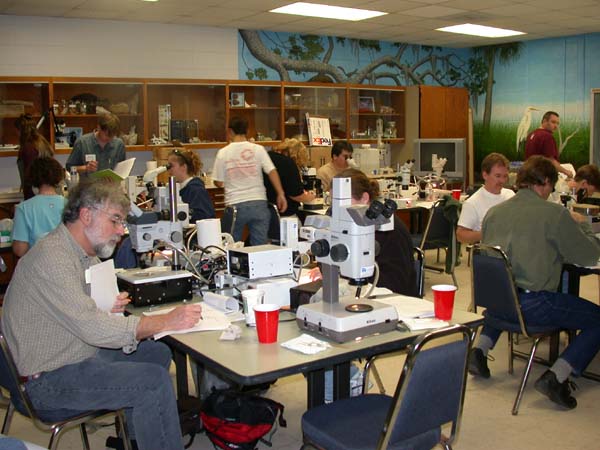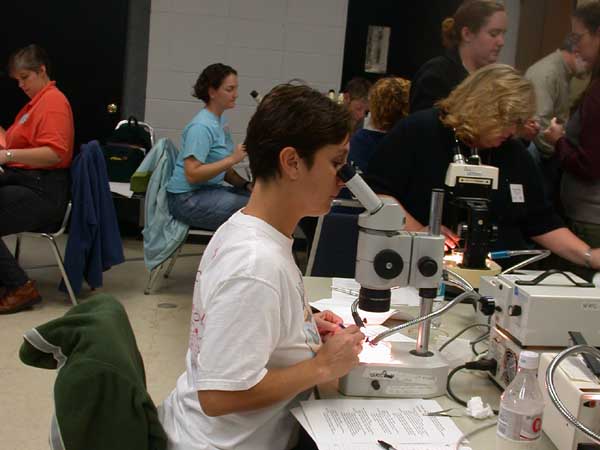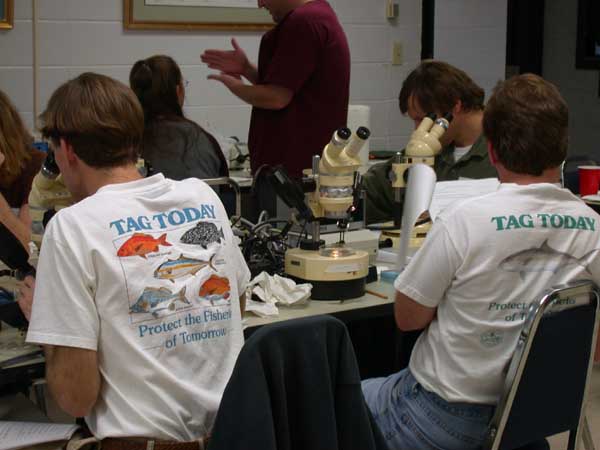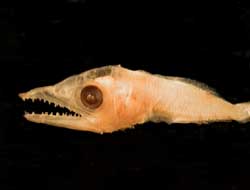
Participants of the Larval Fish Taxonomic Workshop
work on lab practical exercises.

Katie Rathmell of University of South Florida examines
larval fish specimens.
 "Tag Team" SEAMAPers David Wyanski and
Byron White identify larval fish.
"Tag Team" SEAMAPers David Wyanski and
Byron White identify larval fish.
 Instructor Jack McGovern, participants Alison White,
Marcel Reichert, Byron White, Josh Loefer, and DNR biologist Pat
Harris enjoy the evening social.
Instructor Jack McGovern, participants Alison White,
Marcel Reichert, Byron White, Josh Loefer, and DNR biologist Pat
Harris enjoy the evening social.
Previous
workshops
The
6th Crustacean DELTA Workshop, October
25-29, 2004. (instructed by Jim
Lowry, Australian Museum, and Terry Macfarlane, Western Australian Herbarium). This workshop
served to train taxonomists to use DELTA
(DEscriptive Language for TAxonomy), a windows based taxonomic
database that stores morphological data and illustrations and
them available in the form of natural language descriptions, illustrated
interactive keys, and as output for phylogenetic analyses.
Workshop
on Taxonomy and Identification of Marine Fishes, with an Emphasis
on Western North Atlantic Species, July 13-15, 2004. (instructed
by Dr. Antony Harold, GML/CofC, and Dr. Randall Mooi, Milwaukee
Public Museum). This workshop served to train participants in
the systematics and identification of marine fishes of the southeastern
United States. Designed for graduate students, postdoctoral investigators,
other investigators studying the biology of marine fishes, and
professional resource managers, the workshop provided an introduction
to fish taxonomy, phylogenetic systematics, curatorial issues
in research, and an introduction to the use and application of
dichotomous keys and descriptive accounts. Field activities aboard
the R/V ANITA of the South Carolina Department of Natural
Resources allowed students to obtain an array of fresh material
for identification in the laboratory.
Taxonomic Workshop on the Identification
of Decapod Crustacea from the Atlantic Coast of the Southeastern
United States, January 21-23, 2004. (instructed by
Dr. Darryl Felder, UL Lafayette, Dr. Richard Heard, USM,
and Dr. Elizabeth Wenner, SCDNR). This workshop served to train
advanced students, educators, and scientists in the systematics
and identification of decapods of the Southeastern United States.
Emphasis was placed on diagnostic morphological characteristics
and the use of keys.





 "Tag Team" SEAMAPers David Wyanski and
Byron White identify larval fish.
"Tag Team" SEAMAPers David Wyanski and
Byron White identify larval fish.
 Instructor Jack McGovern, participants Alison White,
Marcel Reichert, Byron White, Josh Loefer, and DNR biologist Pat
Harris enjoy the evening social.
Instructor Jack McGovern, participants Alison White,
Marcel Reichert, Byron White, Josh Loefer, and DNR biologist Pat
Harris enjoy the evening social.